
John Curtin College of the Arts, originally John Curtin High School, is an independent, public co-educational, partially selective high school, located in East Street, Fremantle, a suburb of Perth, Western Australia.
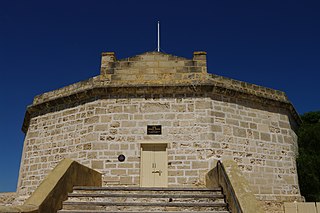
The Round House was the first permanent building built in the Swan River Colony. Built in late 1830 and opened in 1831, it is the oldest building still standing in Western Australia.
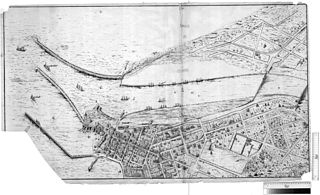
Victoria Quay is a wharf on the south bank of the Swan River mouth in the Western Australian port city of Fremantle. It is separated from the Fremantle CBD by the railway line. Originally named South Quay, it was renamed Victoria Quay on 26 July 1901 in honour of the late Queen Victoria. With North Quay it forms the Inner Harbour area of Fremantle Harbour.

The Esplanade Hotel is a hotel located opposite Esplanade Park in Fremantle, Western Australia. The building stands on the site of the first building used for housing convicts transported from Great Britain in 1850.

The McDonald Smith Building is a heritage building in the port city of Fremantle, Western Australia. The building dates from the gold rush boom period in the late nineteenth and early twentieth centuries and is of historic significance.

The Old Fremantle Police Station and Court House Complex is a heritage-listed group of buildings located at 45 Henderson Street, Fremantle, Western Australia. The complex includes the former courthouse, police station, police barracks and lock-up and artillery drill hall.

Customs House and former Falk & Company Warehouse is an historic three-storey brick building located in Fremantle, Western Australia. The building has a number of prominent ornate façades on Phillimore Street between Henry and Pakenham Streets. It houses the Fremantle regional office of the Australian Customs and Border Protection Service, Centrelink, and a number of other Australian Government offices.
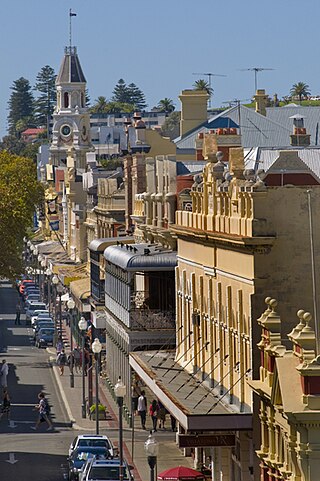
High Street is the main street running through the City of Fremantle, Western Australia. The street passes by historic landmarks, including the Round House, the Fremantle Town Hall, and the Fremantle War Memorial, through the Fremantle West End Heritage area and through two town squares. Trams operated along High Street for 47 years, between 1905 and 1952. Running east–west, High Street continues as Leach Highway, a major arterial road, at Stirling Highway, linking Fremantle with Perth Airport although the stretch of road between Stirling Highway and Carrington Street is known locally—and signed—as High Street.

The Fremantle Post Office located in Market Street, Fremantle was designed by Hillson Beasley of the Public Works Department, planned in 1906 and opened in 1907. It was renovated during the Western Australian Centenary year of 1929, and again in 1987 for the America's Cup challenge. It continues to serve as a post office.
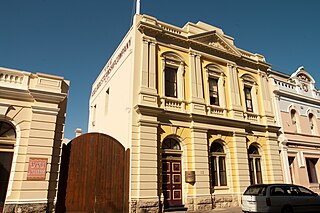
The Adelaide Steamship House is located at 10-12 Mouat Street, Fremantle. Built in 1900, the building was designed by Fremantle-based architectural firm Charles Oldham and Herbert Eales and was constructed by C. Coghill. The building takes its name from the original owners of the building, the Adelaide Steamship Company, who provided sea passenger and freight services around Australia.

The Marich Buildings is a single two-storey building at the corner of Henry and High Streets in Fremantle, Western Australia, and dates from c1897; there were several single-storey shops on the site including one occupied by butchers Henry Albert & Co.
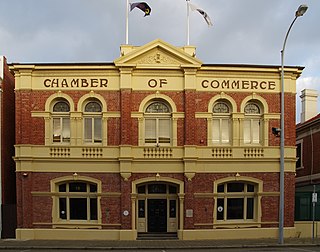
The Fremantle Chamber of Commerce is a business and commerce advocacy association in Fremantle, Western Australia.

Mouat Street is a 300-metre-long (980 ft) street in Fremantle, Western Australia. Historically, the name was often spelled as Mouatt Street.

The Princess Theatre, located at 29–33 Market Street, Fremantle, Australia, was built in 1912. It closed in 1969 and is now used for offices and retail businesses.
Cliff Street is a street in Fremantle, Western Australia. It is the furthest west cross street on High Street, running parallel to Mouat Street. It is also at the south western edge of University of Notre Dame campus buildings. It is part of the Fremantle West End Heritage area, which was established in late 2016.

Phillimore Street is a street in Fremantle, Western Australia; it runs between Queen Street, outside the Fremantle railway station and Cliff Street.

Fremantle West End Heritage area is a designated heritage precinct in Fremantle, Western Australia.

Pakenham Street is a street in Fremantle, Western Australia, in the Fremantle West End Heritage area. It runs between Phillimore Street and Collie Street, the main cross intersection being with High Street.

The Fremantle Synagogue is a heritage listed building located on South Terrace on the corner of Parry Street in Fremantle, Western Australia. It was the first synagogue built in Western Australia and was associated with Jewish community leaders and merchants in Fremantle at the end of the 19th century. The building is also known as Beers building.




















